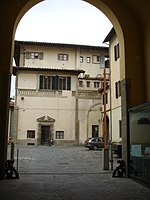Sant'Apollonia
1339 establishments in Europe14th-century establishments in the Republic of Florence15th-century Roman Catholic church buildings in ItalyFormer churches in FlorenceItalian building and structure stubs ... and 1 more
National museums of Italy

Sant'Apollonia was a former Benedictine convent, founded in 1339, just north of the center of Florence, in Italy. Some of the remaining structures are demarcated on three sides by via Ventisette Aprile, via Santa Reparata, and Via San Gallo, located about a block west of Piazza San Marco, just north of the city center. The structures of the convent, suppressed since the 19th-century, are now put to different uses. The small church building is still present on the corner of Via Ventisette Aprile and San Gallo.
Excerpt from the Wikipedia article Sant'Apollonia (License: CC BY-SA 3.0, Authors, Images).Sant'Apollonia
Via Santa Reparata, Florence Quartiere 1
Geographical coordinates (GPS) Address Nearby Places Show on map
Geographical coordinates (GPS)
| Latitude | Longitude |
|---|---|
| N 43.778668 ° | E 11.256569 ° |
Address
Complesso di Sant'Apollonia
Via Santa Reparata
50112 Florence, Quartiere 1
Tuscany, Italy
Open on Google Maps









